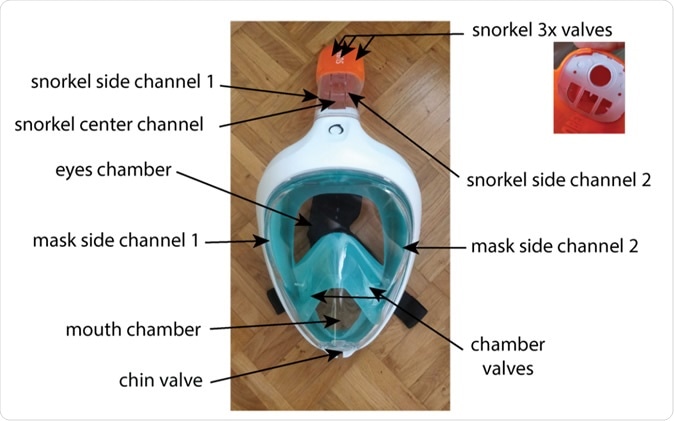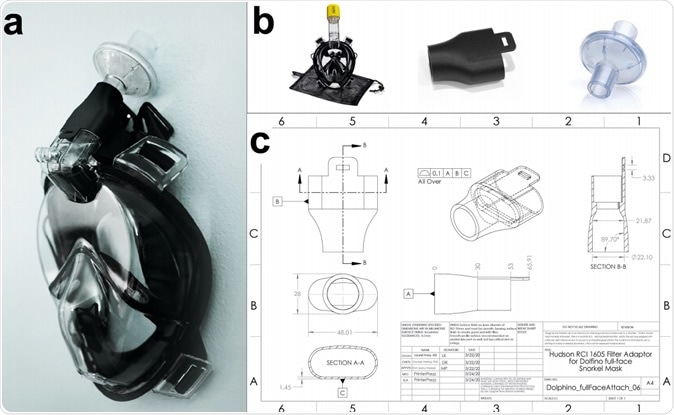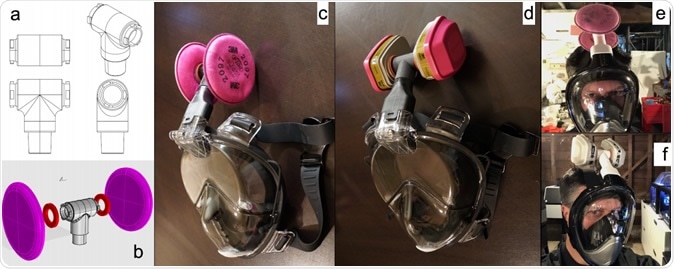In the context of today’s COVID-19 crisis, where health workers are on the frontline day and night, personal protective equipment (PPE) has become paramount in keeping them healthy. However, the availability of PPE is far from keeping up with the immense scale of demand.
Ingenious adaptation
The researchers evaluate the use of an adaptation easily applicable to a full-face off-the-shelf standard snorkel mask as a contingency solution to the current shortage of PPE. The principal advantage is that these masks are already available in large quantities.
The study says, “This project is an effort to provide a safer solution to the current PPE shortage crisis compared to untested homemade masks or bandanas, which often cannot provide good seals around the face and are not tested for high filtration efficiency.”
The design
The novel adaptation described in the paper converts the mask into a full-face shield with an air seal and filter inflow and outflow of air. Snorkel masks usually have a snorkel airport at the top, with one inhale channel and two for exhaled air. An additional exhale port with a one-way valve is situated at the chin or mouth area in most models.

Figure 1 (A) Proposed Pneumask and (B) Prototype pictured on user. The snorkel mask is connected to an inline viral filter to provide protections to healthcare workers. The snorkel mask and adapter can be disinfected thus provide a reusable solution.
With the modified mask, inhale air comes through a coupled filter, with most of the exhale air leaving through the chin valve. The mask can undergo standard disinfection protocols without losing its air seal, allowing its reuse.
The mask is meant for use by doctors, nurses, and hospital staff who have to operate without standard FDA-approved PPE. The primary motivation behind the mask is to prevent the spread of infection to a healthy user, in contrast to many other designs meant for use by patients on a ventilator. These are designed to keep the environment free of contamination.

Thus, the mask user is assumed to be both alert and active, to use standard operating protocols, and to be able to have the mask sterilized and disinfected as per hospital standards. At present, the filters used with the Pneumask are only available to doctors and others who work in hospitals and not to patients.
The snorkel port of this standard mask is connected to a filter via a custom-made adapter. Two approaches are possible concerning the filter. It can either be a ready-made medical-grade respiratory filter connected inline directly to the adapter or an alternative filter such as a pair of industrial P-100 filters rated by the NIOSH to be connected through another modular adapter.
The benefit of using such filters is that they remain operational for much longer than the currently used N95 respirators, which are disposable masks.

(A) This is the first solution that enables use of a snorkel mask to be used as a full reusable PPE; including (B, from left to right) Dolfino full face snorkel mask, an adapter, and a Hudson RCI 1605 inline filter. (C) The design is based on the connector standard ISO 5356-1:2015 Anaesthetic and respiratory equipment - Conical connectors - part 1: Cones and Sockets). A newer version of this part was adapted for use with injection molding by Boston Scientific.
The design lends itself to two requirements, with the use of two coupling adapter pieces. For anesthesiologists and other general staff, there is no need for a sterile field. In other words, the exhale air does not have to be filtered or directed away from the patient. This is the most common use situation, for which the Pneumask-G is recommended.
For surgeons, the air must be kept away from the patient. This accounts for a small minority of use. The Pneumask-S is meant for these situations. It can also be used when a surgeon fails the fit test with the N95 masks because the typical alternative used currently, namely, the positive air pressure respirators (PAPR), is challenging to use in a surgical procedure.

(a) Part Design of a male 22mm ISO to two standard turn socket ports for industrial-grade filters. (b) Assembly with two P100 filters (Part 2097, 3M), (c-d) Mask assembly with multiple types of industrial NIOSH filters. (e-f) Full assembly on Dominic Peralta with different filter types.
Validating the design
The respiratory PPE is meant to keep the user from suffering exposure to infectious particles in the respiratory droplets from an infected person. However, small amounts of exposure may occur with the presence of a leak at the face, filter penetration, and internal contamination.
The face leak depends on the fit of the mask, which varies with face shape and mask shape. It needs to be independently verified for each user. Filter penetration is blocked by using a high-efficiency filter material. Mask contamination can be minimized by proper user training, proper custom maintenance, and adequate storage after sterilization.
Fit testing found that it could form a competent seal above the standards of a half-face respirator or standard N95 masks. The independent filter testing also shows that the performance is equal to the N95 standards, if not higher, though the filter quality determines the actual performance limit.
The carbon dioxide buildup and the clinical usability of the mask were also tested, and the device passed these criteria. The device allows the user to see sufficiently well, and speech, though “somewhat muffled,” can be made audible by amplification if the environment is too noisy. Amplification is achieved via Bluetooth voice relay to cell phone speakers via an app.
The researchers sum up: “The benefit of the Pneumask as PPE is that it is reusable for longer periods than typical disposable N95 respirators, as the snorkel mask can withstand rigorous decontamination protocols (that are standard to regular elastomeric respirators). With the dire, worldwide shortage of PPE for medical personnel, our conclusions on the performance and efficacy of Pneumask as an N95-alternative technology are cautiously optimistic.”
Important Notice
medRxiv publishes preliminary scientific reports that are not peer-reviewed and, therefore, not be regarded as conclusive, guide clinical practice/health-related behavior, or treated as established information.